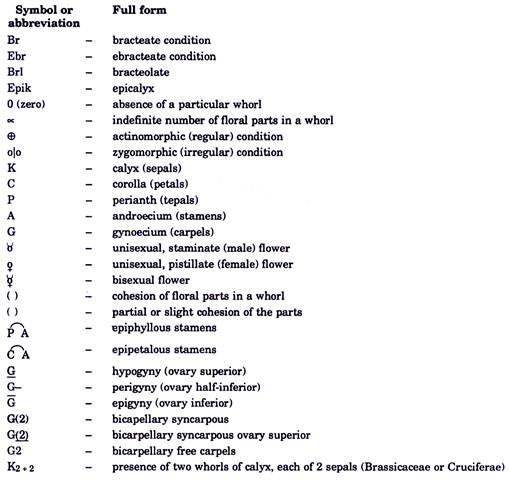In this article we will discuss about:- 1. Meaning of Floral Formula 2. Symbols Used in Construction of Floral Formula 3. How to Write Floral Formula? 4. How to Read Floral Formula?.
Meaning of Floral Formula:
It is a symbolic and numerical representation of various floral parts. It also furnishes information regarding symmetry, sexuality and interrelationship of various floral parts viz., calyx, corolla, androecium and gynoecium.
Numerology of Symbols:
A number put just after the symbol represents the number of parts in that particular whorl. If the parts of a whorl are united then the number is bracketed e.g.
If five free sepals are present the whorl is represented by K5 and if united it is represented by K(5).
If there are more than one whorl of an organ, they are represented by the some of their representative parts. If a flower has three whorls of five stamens each, then the androecium is represented by A5+5+5.
If one organ is united with other organ then an arrow is made. It starts from the top of one symbol and ends on the top of the symbol for the other organ with which united e.g., if each of the five petals bears the stamens the union of two organs is represented as below;
The epigenous condition of a flower is represented by a line placed above the number of carpels. While its hypogenous condition is represented by under-lining the number of its carpels e.g. The epigenous flower with five carpels is written G5 and the same type of hypogenous flower with five carpels is written as G5.
The missing organ is represented by putting a zero or 0 after its symbol. If the number of organs in a whorl is more than ten its symbol is followed by the mark of infinity or ∞.
Symbols Used in Construction of Floral Formula:
Symbols used in construction of floral formulae are as below:
How to Write Floral Formula?
The writing of floral formula one should start from bract and bracteole then symmetry and sex of flower, calyx, corolla, androecium and gynoecium. The number of parts of each organ is indicated in figures (1, …… 4, 5) after the relevant symbol (K, C, A, G).
If the parts are free, the figure numeral is placed as such but if they are united, the numeral figure is placed inside bracket (see numerology of symbols). In bilabiate structure, the number of parts broken into two figures depending upon the number of parts in the upper and lower lip.
Adnation of members of different whorls is shown by joining the top of their symbols by a curved line ![]()
A break in the alternation of parts of any two successive floral cycles is indicated by inserting a vertical line between the symbols of the two floral cycles. The position of ovary whether, it is superior, half inferior or inferior is shown by placing a horizontal line below in front and above the symbol of gynoecium respectively.
How to Read Floral Formula?
The following examples illustrate the methods of reading and constructing the floral formulae:
The formulae read as follows:
Lathyrus:
Flower zygomorphic, hermaphrodite, gamosepalous, calyx with five sepals; polypetalous, corolla with five petals; androecium with ten stamens, diadelphous; gynoecium superior of one carpel.
Ipomoea:
Flower actinomorphic, hermaphrodite; calyx polysepalous with five sepals; corolla gamopetalous with five petals; androecium with five free epipetalous stamens; gynoecium syncarpous with two superior carpels.

